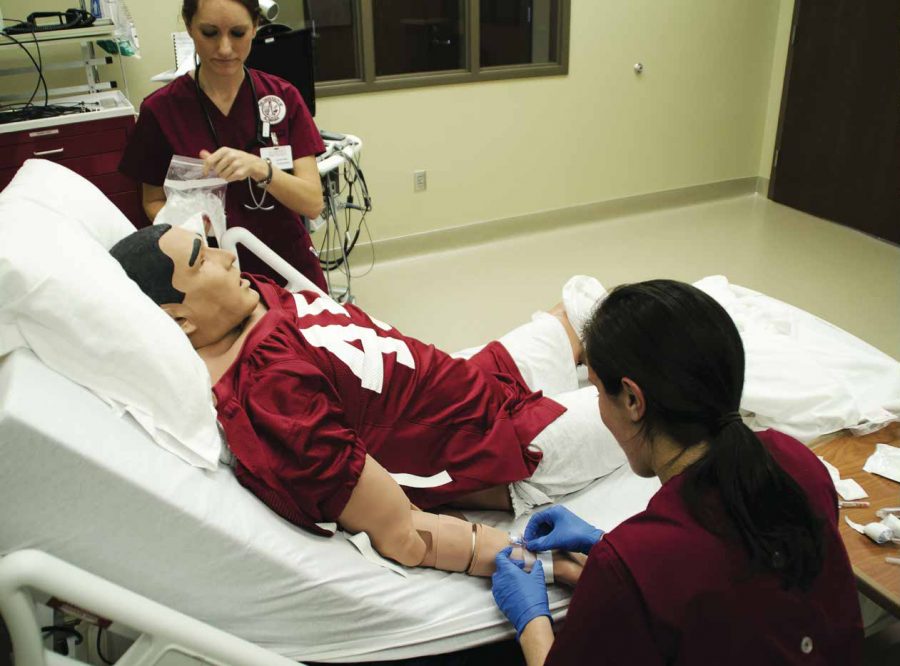He looked like a football player suffering from dehydration propped in a hospital bed. The distorted face and plastic limbs ruined the illusion as the manikin sat lifeless, simulating short breaths and blinks.
With wires instead of veins, the manikin is one of 13 The University of Alabama’s School of Nursing owns that can suffer any medical problem, talk and give the impression of bodily functions. The manikin’s limbs cannot move, but nursing students can inject medicine, attach an IV, deal with fake blood and more. The faculty has a nearly limitless ability to create any simulation from adding wounds to burns to heart attacks – even simulating labor.
Andrea Sartain, the human patient simulation support specialist, said before each simulation, the manikins are prepped with one to two faculty members in the control room, creating the scenario on computers. One to four students will come to the hospital room replica with only some prep work for the awaiting situation. With the faculty controlling the vitals and every aspect of the patient behind one-way mirrors, students walk into the unexpected.
“Nurses have to be able to think on their feet at all times, and they have to be able to use their critical thinking skills no matter what field of nursing they go into,” Sartain said, “[The simulations] allow us to challenge our students to use those critical thinking skills and see what they can do on their own.”
The University got its first manikin in 2005. Now, with manikins that can change gender, a female simulator that can give birth, pediatric manikins, a toddler and a newborn baby, the school has a wider repertoire to offer its students a range of experiences.
Hayley Strickland, a course leader for the fundamentals of nursing, said a large portion of nursing education is to develop students’ clinical judgment skills.
“By doing simulations, we can put them in a specific scenario they will encounter in a hospital and then critique how they perform, so hopefully when they encounter it in the hospital, they are going to make appropriate decisions,” Strickland said.
The faculty gives students a variety of scenarios that some may never see in the field. Caitlyn Camp and Brittany Alexander, both juniors majoring in nursing, completed a blood transfusion in their simulation. In a process that involved a complaining patient, calling the doctor, getting blood then setting it up and dealing with the patient’s allergic reaction to the blood, their scenario challenged them in a new way.
Camp said these simulations give students experience in rarer occasions.
“We see stuff you couldn’t control in the hospital,” Camp said. “There’s no way we’re guaranteed to see a blood transfusion in the hospital. In the simulations, we can see it and know what to expect.”
When entering such high-pressure scenarios with no guidance, students must apply what they learned from class. Since every patient is different, this is a challenging concept.
Alexander said although she was nervous the first time she entered a simulation, she thought in the best interest of her future patients.
“You have to think about what is most critical to the patient’s safety and get them what they need the most,” Alexander said. “You have to advocate for the patient, because the doctor is not on the floor 24 hours a day with the patient, so you have to see what’s going on and tell the doctor.”
After each simulation, the faculty debrief the students. The scene is filmed and used it to let students see how they performed. These tools are used to ensure that students have the liberty to make mistakes. In clinical situations, faculty members hover by students to stop them from committing an error. In these simulations, students are left to think independently and can kill their patient with the ability to hit the restart button.
“We want this environment to be one where they are not afraid of failing,” Sartain said. “We want them to come in and act autonomously, and we don’t want them to fear failure, because we learn best from our mistakes, so we’d rather them make those here in a controlled environment instead of on a real patient.”







